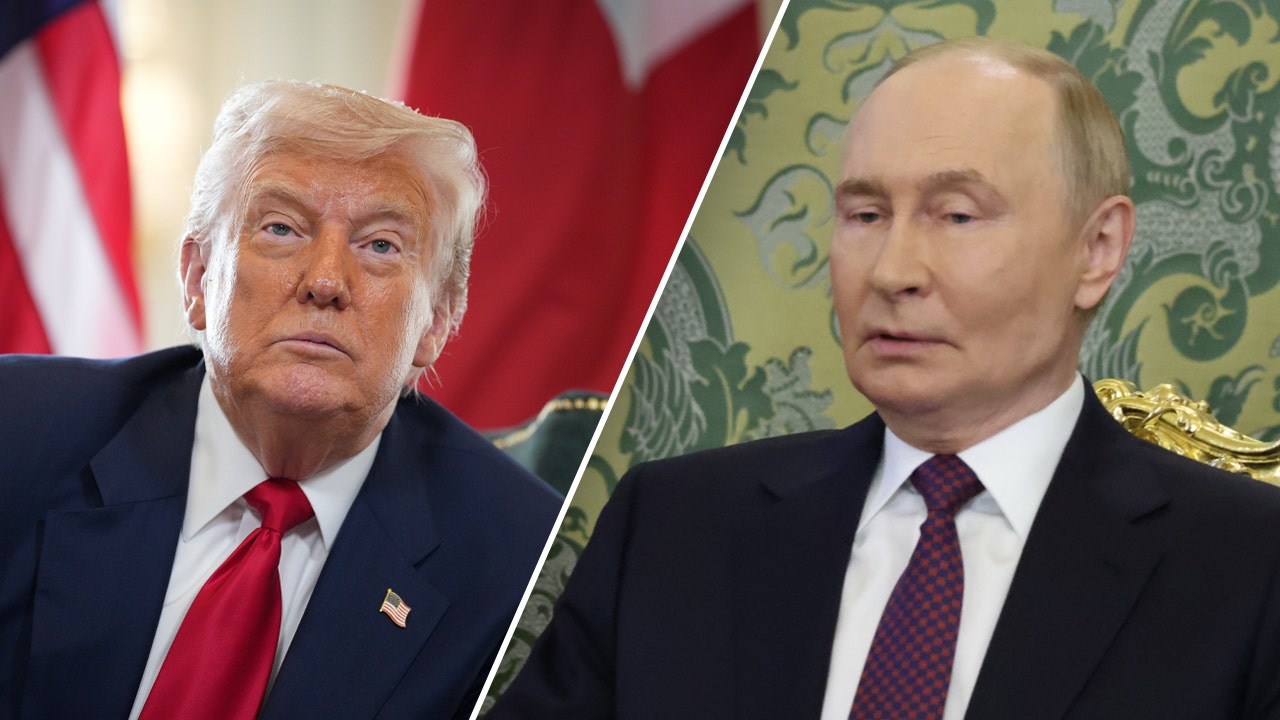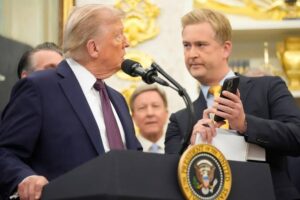Peter Doocy Puts Questions: Trump Really Had Enough of Putin

Energy industry attacks put pressure on Putin as Kremlin fears that the deficiency may unstable Russia. Today we will discuss about Peter Doocy Puts Questions: Trump Really Had Enough of Putin
Peter Doocy Puts Questions: Trump Really Had Enough of Putin
Peter Doocy, senior White House correspondent for Fox News, has long been known for his pointed and persistent questions to Presidents, particularly Donald Trump. In recent months, Doocy’s questioning has shone a spotlight on a developing tension: Did President Trump finally reach a breaking point with Vladimir Putin? Has the U.S.–Russia relationship under Trump shifted from cautious engagement to open frustration?
This article explores Doocy’s role as a questioner, the exchanges between Doocy and Trump (and by extension, Putin), how Trump is narrating his relationship with Putin now, and what this might mean for U.S. foreign policy and the Russia–Ukraine war.
Peter Doocy: The Questioner in the Crosshairs

To understand the significance of these exchanges, it helps to know who Peter Doocy is and why his questions often become headlines.
Background & Role
-
Peter Doocy is a senior White House correspondent for Fox News.
-
He also co-anchors The Sunday Briefing alongside Jacqui Heinrich, analyzing key moments in the Trump administration.
-
His style is often direct, sometimes persistent, and he frequently presses White House officials and the president on contradictions, clarifications, or bold statements.
Over the years, Doocy has asked Trump hard questions on policy, scandals, and foreign affairs. His exchanges sometimes reveal internal tensions, shifts in messaging, or cracks in unified narratives. When Doocy presses Trump about Putin, those moments tend to carry particular weight, given the complexity and sensitivity of U.S.–Russia relations.
The Context: Trump, Putin & Ukraine
Before diving into specific Doocy–Trump exchanges, it is necessary to map the context: how Trump has treated Putin over recent months, how the Russia–Ukraine war has evolved, and what expectations have shifted.
The 2025 Trump–Putin Summit in Alaska
-
On August 15, 2025, Trump and Putin met in Anchorage, Alaska, in a much-anticipated summit.
-
The summit was framed as a diplomatic moment to push toward peace in Ukraine, but it ended without a clear agreement or immediate breakthrough.
-
Trump later claimed “great progress” but deferred key decisions to Ukraine and Putin.
-
Critics noted the optics (e.g. allowing Putin to ride in the U.S. presidential limousine) while substantive concessions were minimal.
This summit underscored both Trump’s willingness to engage Putin directly—and how little concrete outcome materialized.
Trump’s Shifting Tone Over Putin
In the weeks and months following the Alaska meeting, Trump’s rhetoric toward Putin has evolved. Several developments are worth noting:
-
Expressed Disappointment
In a Fox News interview aired September 18, 2025, Trump said that resolving the war in Ukraine has been more difficult than expected and admitted he was “very disappointed” in Putin. -
“Let Me Down” Remark
At a press conference during his state visit to the UK, Trump said, “He’s let me down. He’s really let me down,” referring to Putin’s unfulfilled promises regarding peace negotiations. -
Public Re-assessment of Their Relationship
At the UN General Assembly, Trump asserted that his prior relationship with Putin “meant nothing,” effectively distancing himself from past associations. -
Blunter Critiques
In a joint press conference with UK Prime Minister Keir Starmer, Trump criticized Putin for failing to cooperate on peace concessions, and hinted that European reliance on Russian energy might force Russia into a settlement.
These shifts reflect growing public frustration from Trump toward Putin’s intransigence, and perhaps a pivot in how the U.S. positions itself diplomatically in the Russia–Ukraine conflict.
Wider Stakes: Ukraine, European Energy, and U.S. Credibility
The backdrop to these statements is the ongoing war in Ukraine. U.S. involvement, European energy dependence on Russia, and global perceptions of American resolve are all interconnected.
-
European nations still purchasing Russian oil is a recurring gripe from Trump; he suggests reducing demand to pressure Putin.
-
Observers have speculated that Trump’s harsh rhetoric is intended as a negotiating tactic to realign leverage.
-
Conversely, critics warn that fluctuating messaging from the U.S. could reduce credibility or empower Russia’s diplomatic maneuvering.
It is in this contested arena that Doocy’s questions become probing signifiers of where the Trump administration might be leaning.
Doocy’s Questions: “Did Trump Really Have Enough of Putin?”
The central hook—“Peter Doocy Puts Questions: Did Trump Really Have Enough of Putin?”—is not merely rhetorical. Doocy’s inquiries help surface how the Trump White House is trying to narrate, justify, or distance itself from the evolving relationship with Putin.
Key Exchanges & Questions
While there is no public transcript labeled exactly that, the phrase echoes a pattern: Doocy pressing Trump on how much trust remains in Putin.
-
Is Putin the “Good Guy or Bad Guy”?
In some recorded media, Doocy asked Trump whether Putin was the “good guy or bad guy” amidst the Russia–Ukraine war. -
Such a question forces a binary moral positioning. It places Trump in a tight spot: either he condemns Putin outright (a break from earlier overtures) or remains equivocal (suggesting continued ambiguity).
-
Doocy Highlights Trump’s Frustration
A Fox News video clip is titled “Peter Doocy: Trump has HAD IT with Putin.”
While the title is editorialized, it captures how Doocy frames the relationship: as strained to breaking. -
Contextual Prompts in Broadcasts
In coverage of Trump’s remarks at the UN or his statements on Ukraine, Doocy often frames the question in terms of “Why now?” and “What changed?” — implicitly asking why Trump’s tone toward Putin is shifting.
In effect, Doocy’s questioning helps expose whether Trump is pivoting in policy, language, or personal stance toward Putin.
Functions & Impact of Such Questions
-
Accountability & Contradiction
By confronting Trump with stark questions about Putin’s character or reliability, Doocy compels him to reconcile prior statements with current tone shifts. -
Public Narration
The questions frame the narrative: is this a strategic repositioning, a genuine rupture, or political theater? -
Signaling to Audiences
Doocy’s queries also signal to viewers that even within pro-administration media, skepticism exists. They invite audiences to re-evaluate whether Trump’s compliments or past overtures to Putin were misguided. -
Agenda Setting
These questions can push the White House to clarify policy, not hide behind vague diplomacy.
Thus, Doocy’s role is more than adversarial; it is a kind of internal pressure, shaping how the administration must explain evolving positions.
Did Trump Really Have Enough? Interpreting the Signals
So: Is the rhetoric real? Or is this just political theater, recalibration, or tactical repositioning? Below, several possible interpretations.
1. Tactical Repositioning: Negotiation, Not Reversal
One possibility is that Trump’s tougher talk is a negotiation tactic, rather than an outright rupture.
-
Some within the administration have described Trump’s harsher rhetoric as a way to pressure Putin, not as a full-on break.
-
Trump’s willingness to engage Putin directly, offer mediation, or invite Zelenskyy–Putin talks suggests he still sees value in direct diplomacy.
In this reading, Doocy’s questions serve to expose whether the administration is holding cards close to the chest.
2. Genuine Frustration & Course Correction
The shift from warmth to criticism could reflect genuine disillusionment with Putin’s intransigence.
-
Trump’s public admissions—“he’s let me down”—carry emotional weight.
-
His distancing statements (“our relationship meant nothing”) suggest an effort to undo earlier goodwill.
If real, this could usher in a tougher U.S. posture on Russia, less quiet support, and more emphasis on leveraging Europe and alliances.
3. Political Messaging for Domestic Audiences
Another angle: the shift might be more about messaging to swing voters, critics, or other political stakeholders than about pure foreign policy.
-
Criticizing Putin can broaden appeal among hawkish voters or distancing from accusations of being soft on Russia.
-
It may help preempt domestic attacks: if Trump is seen as having been too lenient, now he can say “I tried, I was betrayed.”
In this sense, Doocy’s tough questions help expose tension between public messaging and behind-the-scenes strategy.
4. Mixed Strategy: Staged Ambiguity
Most likely, the reality blends these interpretations. The Trump administration may maintain ambiguity: harsh public rhetoric, but behind-the-scenes encouragement for talks.
-
A more punitive public line, but with backchannels still open.
-
Using European energy dependence, sanctions, or diplomatic pressure while offering Putin a “way out.”
Doocy’s probing ensures that if ambiguity becomes opportunistic, it will be harder to spin.
Implications & Risks
The apparent shift in tone—and Doocy’s public role in surfacing it—carry real implications.
For U.S. Foreign Policy
-
A tougher public line could allow the U.S. to push Europe to reduce dependence on Russian energy and strengthen sanctions.
-
It may set the groundwork for renewed U.S. military or economic aid to Ukraine under tougher conditions.
-
Conversely, inconsistent messaging might weaken U.S. credibility among allies or embolden Russian miscalculation.
For Russia & Putin
-
Putin must decide whether to respond to Trump’s tougher posture or stay the course.
-
If Putin perceives the rhetoric as bluster, he might double down on Ukraine operations.
-
If he sees opening, Russia could attempt new diplomatic overtures.
For Media & Public Discourse
-
Doocy’s questioning shows how individual journalists can shape narratives, hold power to account, and influence policy discussions.
-
It may encourage other journalists to pose more assertive questions of world leaders.
-
The public may begin to read more critically: Are diplomatic statements sincere or strategic?
Conclusion
Peter Doocy’s direct, forceful questions—especially when targeted at Trump about Putin—play a significant role in uncovering shifts in tone and policy. The question “Did Trump really have enough of Putin?” is not rhetorical: it invites examination of whether Trump’s frustration is real, tactical, or a bit of both.
As the Russia–Ukraine war continues and global stakes rise, the way Trump frames his relationship with Putin matters. Doocy’s role, in prodding, challenging, and eliciting clarity (or exposing ambiguity), becomes a microcosm of broader tensions: between diplomacy and pressure, between public messaging and behind-the-scenes strategy, and between personal rapport and national interest.
In short: we should watch closely how Trump answers Doocy’s questions—not just now, but over time. Because in those exchanges lies evolving U.S. posture toward Russia, and perhaps the future arc of the Ukraine conflict.
How useful was this post?
Click on a star to rate it!
Average rating 0 / 5. Vote count: 0
No votes so far! Be the first to rate this post.
About the Author
usa5911.com
Administrator
Hi, I’m Gurdeep Singh, a professional content writer from India with over 3 years of experience in the field. I specialize in covering U.S. politics, delivering timely and engaging content tailored specifically for an American audience. Along with my dedicated team, we track and report on all the latest political trends, news, and in-depth analysis shaping the United States today. Our goal is to provide clear, factual, and compelling content that keeps readers informed and engaged with the ever-changing political landscape.




